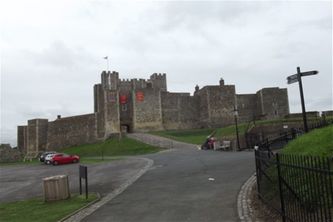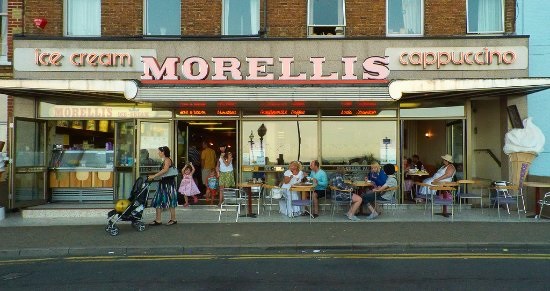Dover Castle in the rain
Wednesday 12 September
Heavy rain overnight followed by a grey damp morning inspired us to do nothing before lunch, just relaxing in the caravan. After lunch it brightened up a bit so we set off for Dover Castle, in the belief that most of the visit would be indoors. Of course it was, it was just that there were several buildings with steep pathways and stairways up and down hill between them, and of course it did rain again. We were grateful for our English Heritage cards, the admission without them being £22 a head. The price did not put off the swarms of foreign students though.
The main castle is huge and pretty much intact. Inside is part reconstruction, part museum, part tableaux. There are stairs at every corner, huge halls and narrow passageways, and it’s very easy to get lost. We passed the same groups of noisy kids several times. At the very top the views over the Castle complex and over Dover were excellent. However after all that climbing we were much in need of refreshment so we fought our way into the very busy café in the stable block.
After this part of the castle complex we climbed another hill to the Roman Lighthouse, converted to a bell tower for the adjacent Anglo Saxon Church of St Mary in Castro, but now empty.
Then it was a long walk down to the lower end of the castle to the entrances to the WW2 tunnels, built as part of the defences of Dover Port and also as a field hospital for the immediate treatment of wounded soldiers. It was amazing to see how hospital wards and operating theatres had been created so far underground, and as we were guided round there was a radio commentary from the time, as if we were really there and expecting the next injured soldier to be brought in behind us. At the end of the tour we had to climb a spiral staircase of 70 or more steps to get back to the surface, followed by a steep climb in the rain to the car park. We were somewhat weary when we got back to the campsite!
Oysters and Ice Cream
Thursday 13 September
Today the sun returned so we decided to explore the coast some more. We started by heading north across country to Whitstable. Here the harbour was a little uninspiring and the beach consisted of mountains of discarded oyster shells. However there was a nice little craft market along the side of the harbour and the famous oyster stalls behind the beach. A nice row of black painted fisherman’s huts have been converted to holiday lets.
The town itself was very pleasant, very Dickensian, with lots of trendy upmarket shops. We found a nice little coffee shop for our morning refreshment, with delicious home made cake. Then it was onward along the north coast to Margate, where we were targeting the Turner Contemporary. We parked on the pier for our visit to the Turner, but were a little disappointed. The building itself was not as impressive as we had expected, the collection was small although the temporary exhibition, on the subject of human’s relationship with animals, was interesting.
We moved the car to a cheaper car park in the old town, close to the Tudor House (which was closed) then walked into the town in search of lunch. We found an excellent little fish restaurant close to the seafront - cockles, fish soup, thornback ray, washed down with a glass of Picpoul.
Margate is the home of one of my childhood (and, yes, I admit it, adulthood) loves, Hornby trains, so we drove out to the Hornby Centre to look at trains, old and new, Scalextric, Meccano and all sorts of other toys and models. To make it up to Lesley we then drove back into Margate to the Shell Grotto, an amazing underground series of tunnels and chambers lined with shells. Its history and purpose are unknown, but there is all sorts of speculation, including black magic, freemasonry or even the Knights Templar. Strange but fascinating.
We thought Margate to be another seaside town down on its luck, tatty in places, but with interesting and attractive parts. We drove home via Broadstairs, which by contrast was much smarter, more genteel and once again rather Dickensian. And of course, being afternoon tea time we had to start our visit with refreshment. As it happened we were parked very close to an amazing ice cream parlour, Morelli’s. I was disappointed when Lesley said we should share, but when the confection came it was big enough for a family.
Suitably refreshed we had a nice walk along the cliff tops overlooking Viking Bay and then took the lift down to beach level. There is no promenade at this level, but the sandy bay is backed by beach huts. A very pleasant spot indeed. At the end of the bay, on the cliff tops, is a house used by Charles Dickens on his frequent visits to Broadstairs. It was here that he wrote David Copperfield. Today it is appropriately called Bleak House and is an up market B&B and wedding venue.
Back at the campsite we found a campervan had parked next to us, so close that we could not get the car into the correct parking position as instructed in Caravan Club rules! We were a bit worried when the couple started to erect an awning and a dog enclosure, but there was not much noise.
Back to Canterbury
Friday 14 September
Next morning we were woken early by next door taking down their awning. We realised how close it was, as every time he bent down to pull a peg his bum hit the side of our caravan.
So, back to Canterbury park and ride, into town, and where better place to start than Tiny Tim’s. Morning coffee and cinnamon toast. This time we visited the loo upstairs, to find that it was at the back of a haunted living room.
Then the Cathedral. £11.50 each to get in, heaving crowds, half of whom probably, like us, failed to get in yesterday. Scaffolding and dustsheets over much of the interior. All in all interesting but a bit disappointing. There were some nice gardens and a peaceful cloister, an old undercroft and crypt, which was being prepared for a service, and of course the monument to Thomas A Becket on the spot where he was slain. Along the side of the high altar were some interesting tombs, but the altar and choir were thronged with foreign students with their notebooks and phones. There was some impressive stained glass, and at least we could get a good look at that.
We popped into the nearby Shakespeare pub for a pint and a sandwich, then over the road to the Roman Museum, which was impressive, being built over the site of a Roman villa. A mosaic floor was discovered in 1868 while excavating the foundations of a building. The floor was preserved in situ. The building was bombed in the war and when archaeologists cleared the site they found more rooms, wall paintings and mosaic corridors. The museum building was constructed on top of this.
Then it was back to the campsite to take our own awning down and prepare for the journey home on Saturday.
Latest comments
28.12 | 08:07
I live in Nysa Poland that is south west on the cheq border.
22.12 | 20:48
Good to hear from you Liam. I recognise your name from EUnitySeahaven. Where in Poland do you live? We enjoyed what we saw, but of course it was only a small corner
22.12 | 14:43
I live in Nysa in Poland. I shall have to visit in the new year when I have my new phone.
Share this page









































